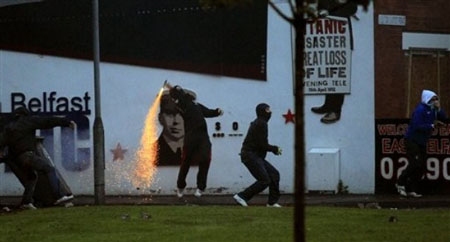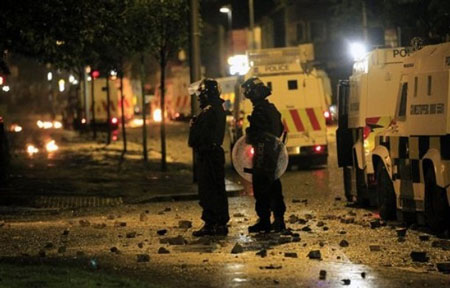A press photographer was shot in the leg and two other people were injured when riots broke out between Protestants and Catholics in Belfast for a second successive night on Tuesday, Reuters Canada reports.
Police said around 700 people threw fireworks, petrol bombs and other missiles in the Newtonards area of the city, a night after two people suffered gunshot wounds in what politicians described as the worst violence of its kind in the area for a decade.
The male photographer was shot in the leg by a gunman on the sidelines of the clashes, witnesses told Reuters and in an unusual move, the police urged all journalists and camera crews to stay out of the area “for their own safety.”
The two men who were injured were suffering from burns, police said.
The police, who had brought reinforcements to the area, responded by firing stun grenades for a second night in a row and local media reported that they had brought two water canon vehicles to the area but had yet to use them.
Some 500 people, many of them youths with their faces covered, fought in the Short Strand area, an enclave of Catholic houses in the predominantly Protestant east side of the city, on the previous night when shots were fired by both sides.
The violence comes at the start of Northern Ireland’s marching season, a time of annual parades by Protestants which has triggered violent protests by Catholics in the past.
“I cannot remember in the last decade a situation like this in the Short Strand,” Colm McKevitt, a member of the regional parliament for the Irish nationalist SDLP party told Irish state broadcaster RTE.
Police blamed members of the Ulster Volunteer Force (UVF), one of the deadliest pro-British paramilitary groups of Northern Ireland’s bloody past, for initiating the first night of disorder.
The UVF said two years ago that it had completed the decommissioning of its weapons in line with other militant groups after a 1998 peace agreement mostly ended three decades of violence in the British-controlled province.
Northern Ireland was torn apart during the violent “Troubles” between loyalists, mostly Protestants, who want it to remain part of the United Kingdom, and Republicans, mostly Catholics, who want it to form part of a united Ireland.
The peace deal paved the way for a power-sharing government of loyalists and Republicans. Violence has subsided over the years, but there are still dissident armed groups.
The parades mainly commemorate historical events, particularly notable British victories, and are regarded by marchers as an expression of cultural identity. Many Catholics see them as provocative.
AP Photos.
 Epress.am News from Armenia
Epress.am News from Armenia

